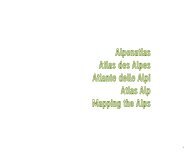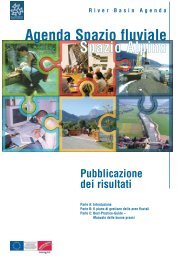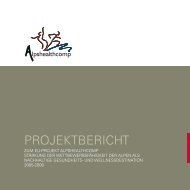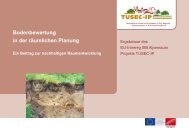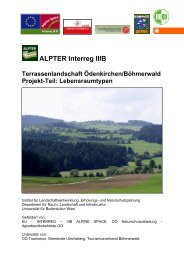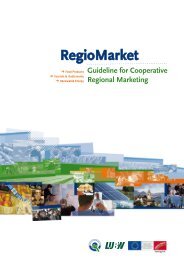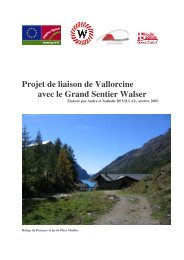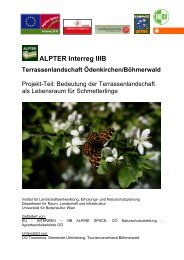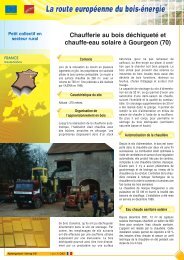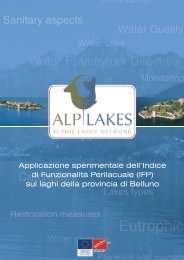1.2 - INTERREG IIIB Alpine Space Programme
1.2 - INTERREG IIIB Alpine Space Programme
1.2 - INTERREG IIIB Alpine Space Programme
Create successful ePaper yourself
Turn your PDF publications into a flip-book with our unique Google optimized e-Paper software.
Aim<br />
ALPNAP 2.1<br />
Monitoring and Minimisation of Traffic-Induced Noise and Air Pollution<br />
Along Major <strong>Alpine</strong> Transport Routes<br />
ALPNAP provides new methods and knowledge to monitor and assess air pollution and noise along transit routes.<br />
Emissions of air pollutants and noise from road and rail traffic<br />
cause serious ecological pressure, impairment of life quality,<br />
nuisances and contribute to health problems. The sensitivity<br />
of the <strong>Alpine</strong> <strong>Space</strong> is often addressed, but arguments and<br />
decisions still lack solid scientific background and a systematic<br />
<strong>Alpine</strong>-wide cooperation of experts is missing. Increasing<br />
traffic volume, new infrastructure, administrative measures or<br />
modal shift will change the emissions.<br />
Reliable environmental impact assessments suffer from the<br />
fact that standard prediction tools have very limited applicability<br />
in valleys. Innovative methods in selected areas, to quantify<br />
the sensitivity of mountain regions to emissions in the valleys<br />
and to demonstrate how traffic regulations can be designed to<br />
meet standards as a function of real emissions and weather<br />
will be applied. The project also aims at a durable <strong>Alpine</strong>-wide<br />
network of experts and authorities, and an increased awareness<br />
of the interaction between nature and human activities<br />
in the Alps.<br />
Inversion in the Adige valley<br />
Activities<br />
The main activity of the project consists of a coordinated and<br />
integrated application of up-to-date science-based methods<br />
and tools to determine the emissions of air pollutants and<br />
noise, to collect measurements of the atmospheric state, concentration<br />
and noise level, to simulate the meteorological situation,<br />
the transport, dispersion and transformation of air pollutants<br />
as well as the propagation of sound, and to assess the<br />
impact on quality of life and health to local population. As an<br />
innovation it will be possible to treat the interaction of topography,<br />
meteorology, emission (both air and noise), transmission<br />
and impact in a consistent way, which allows a cumulative<br />
estimation of the adverse effects. This ensures a comparable<br />
assessment of the consequences of traffic modifications with<br />
respect to both air pollution and noise.<br />
Meteorological and air pollution aspects will be tackled on dif-<br />
ferent scales, ranging from local to <strong>Alpine</strong>-wide. Noise aspects<br />
will be treated across the full valley and in sensitive spots.<br />
The success of ALPNAP will be guaranteed by an intense co-<br />
operation between the project partners and a close link to the<br />
<strong>Alpine</strong> <strong>Space</strong> project MONITRAF (p. 42), in which transport<br />
and environmental authorities are joined.<br />
Outcomes and results<br />
The project will result in a comprehensive report for the use in<br />
decision-making authorities and consulting agencies.<br />
It will comprise:<br />
A description of available modelling tools (atmosphere - air<br />
pollution - noise), how they can be applied to <strong>Alpine</strong> valleys,<br />
their accuracy and their limitations<br />
An assessment of the suitability of various indicators with<br />
regard to its impact<br />
An assessment of errors and possible systematic deviations<br />
that might be encountered by using standard methods in<br />
<strong>Alpine</strong> valleys<br />
Examples of large-scale (whole cross-<strong>Alpine</strong> traverses:<br />
Brenner and Frejus) and small-scale (inner valley locations)<br />
simulated concentration fields of relevant air pollutants (e.g.<br />
NOx, ozone, particles) as a function of emission scenarios<br />
(traffic flow, traffic composition), time of the day and meteorological<br />
situations<br />
The project also intends to produce a brochure for the broader<br />
public that will illustrate the basic relationship between nature<br />
and human activities in the Alps and show the potential of the<br />
current scientific methods.<br />
D<br />
I<br />
F<br />
F<br />
G<br />
I<br />
A<br />
A<br />
I<br />
A<br />
A<br />
Lead partner<br />
Project partner<br />
Lead partner<br />
Deutsches Zentrum für<br />
Luft- und Raumfahrt (DLR)<br />
Other partners<br />
ARPA Piemonte<br />
CETE Lyon<br />
CSTB<br />
IMK – IFU<br />
ISAC – TO<br />
MUI – IHS<br />
TU GRAZ<br />
Univ. di Trento<br />
Univ. BOKU Wien<br />
Univ. Innsbruck<br />
Project website<br />
www.alpnap.org<br />
Contact person<br />
Dietrich Heimann<br />
Tel +49 (0)8153 28 2508<br />
Fax +49 (0)8153 28 1841<br />
dietrich.heimann@dlr.de<br />
Duration<br />
0<strong>1.2</strong>005 – 12.2007<br />
Total budget in EUR<br />
1.989.478<br />
ERDF in EUR<br />
994.736<br />
41<br />
transport



